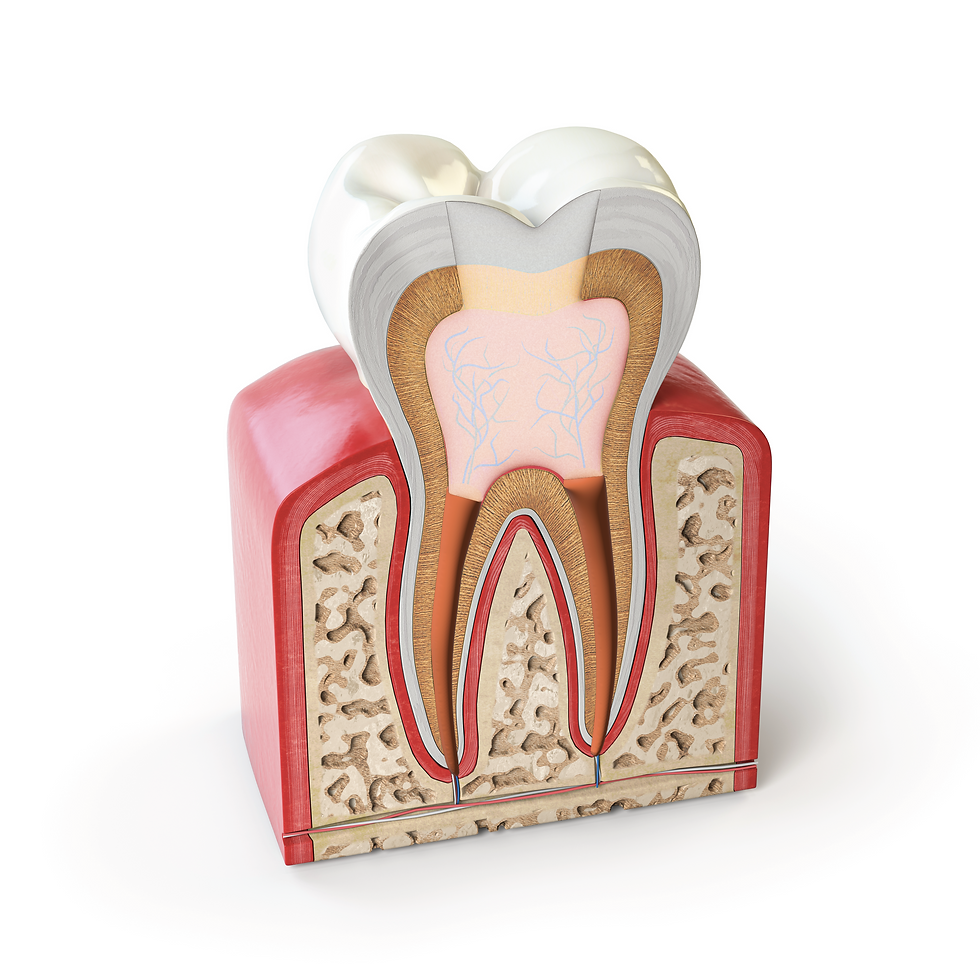
When the pulp becomes infected or inflamed, it can cause pain, swelling, and other symptoms that may require root canal therapy (endodontic treatment).
Endodontics is a specialized branch of dentistry that deals with the diagnosis, prevention, and treatment of diseases and injuries to the dental pulp and surrounding tissues. The dental pulp is the soft tissue that lies within the root canal of the tooth, and it contains nerves, blood vessels, and connective tissue that help nourish and support the tooth. When the pulp becomes infected or inflamed, it can cause pain, swelling, and other symptoms that may require root canal therapy (endodontic treatment).
Root canal therapy helps save teeth that would otherwise need to be extracted. By removing the infected or inflamed pulp, endodontic treatment can prevent the spread of infection to other teeth and tissues in the mouth. Endodontics can help to alleviate pain and discomfort and preserve the natural appearance and function of the tooth, which can have a significant impact on a patient's quality of life.
On this page, we will provide a comprehensive guide to endodontics and root canal therapy to help you understand what to expect during treatment.
Intro to Endodontics


Root canal therapy is typically performed under local anesthesia and can be completed in one or more visits depending on the complexity of the case.

A dentist can diagnose the cause of your symptoms and recommend the appropriate treatment to relieve pain and restore oral health.
The signs and symptoms of dental pulp infection or inflammation may vary depending on the severity of the condition. Some patients may not experience any symptoms, while others may experience one or more of the following. It is important to seek treatment as soon as possible if you experience any of these signs or symptoms. A dentist can diagnose the cause of your symptoms and recommend the appropriate treatment to relieve pain and restore oral health.
Common Signs and Symptoms

Pain
Pain is the most common symptom of dental pulp infection and inflammation. The pain may be sharp or dull and can be constant or intermittent. It may be localized to the affected tooth or may radiate to the surrounding areas of the mouth and face.

Temperature Sensitivity
If you experience sharp pain or sensitivity when eating or drinking hot or cold foods and beverages, it may be a sign of dental pulp infection. This sensitivity occurs because the nerve endings in the tooth pulp are inflamed and more sensitive to temperature changes.

Tooth Discolouration
A tooth with a damaged or infected pulp may appear darker or discolored compared to the surrounding teeth. This discoloration occurs because the damaged pulp causes the tooth to die, and the blood vessels and nerves that supply the tooth are no longer functional.

Bad Breath or Taste
If the pulp of a tooth is infected or inflamed, it can cause bad breath or a foul taste in the mouth. This occurs because the bacteria in the infected pulp release toxins and gases that cause bad breath and an unpleasant taste.

Abscess
An abscess is a pus-filled pocket that forms at the root of the tooth. It can cause severe pain and swelling and may lead to systemic infections if left untreated. An abscess can also cause fever, difficulty swallowing, and lymph node swelling.

Pus Drainage
In severe cases of dental pulp infection, pus may begin to drain from the affected tooth. This pus may have a foul odor and taste and can cause discomfort and embarrassment.

Painful Gums
In addition to pain in the tooth, dental pulp infection and inflammation can cause the gums surrounding the affected tooth to become tender and painful. This can make it difficult to brush and floss properly and may cause bleeding from the gums.

Loose Tooth
A tooth that has been severely damaged or infected may become loose in its socket. This occurs because the tooth is no longer properly supported by the jawbone, and the infection or inflammation has weakened the surrounding tissues.

The inflamed or infected dental pulp is carefully removed using specialized tools and the root canal is cleaned and shaped to remove any remaining debris.
Root canal therapy typically involves the following steps:
Root Canal Therapy Steps





Diagnosis
The dentist will examine the affected tooth and take X-rays to determine the extent of the damage to the dental pulp and surrounding tissues.
Access Opening
After the tooth is frozen with local anesthesia, a small access hole is made to allow the dentist to access the root canal system.
Filling
Biocompatible material is placed to seal the tooth and prevent further infection. A temporary filling may be placed in the access opening to protect the tooth and prevent contamination until a permanent filling or crown can be placed.
Cleaning and Shaping
The inflamed or infected dental pulp is carefully removed using specialized tools and the root canal is cleaned and shaped to remove any remaining debris.
Follow-Up Visits
Depending on the complexity of the case, one or more follow-up visits may be needed to ensure the tooth is healing properly and to place a permanent filling or crown.

Patients should avoid chewing on the affected tooth until it is fully healed and should follow the provided post-operative instructions for caring for the tooth after the procedure.
Benefits of Root Canal Therapy
Root canal therapy is a commonly performed dental procedure that has several benefits. It is a conservative approach that aims to save teeth that are infected or damaged beyond self-healing.

Preserves Natural Teeth
One of the biggest benefits of root canal therapy is that it helps to preserve natural teeth. Extraction is often the only alternative to root canal therapy for a tooth that is infected or damaged. However, preserving natural teeth is always the best option, as they provide better functionality and aesthetics compared to artificial teeth. Extracting a tooth can lead to bone loss in the jaw, which can compromise the structural integrity of the surrounding teeth.

Alleviates Pain and Discomfort
Tooth pain is one of the most common reasons why people seek dental treatment. An infected or inflamed pulp can cause significant pain and discomfort, which can negatively impact a person's quality of life. Root canal therapy removes the damaged or infected pulp, with the goal of alleviating the pain and discomfort caused by the condition.

Prevents Further Infection
When a tooth is infected, the bacteria can spread to the surrounding tissues and cause more serious health problems. If the infection is left untreated, it can lead to an abscess, which is a pus-filled pocket that forms at the root of the tooth. An abscess can cause severe pain and swelling and can lead to systemic infections if left untreated. Root canal therapy removes the infected pulp and prevents a spreading infection.

Restores Functionality
A damaged or infected tooth can compromise a person's ability to chew and speak properly. Root canal therapy aims to restore the functionality of the tooth and allows the patient to eat and speak comfortably.

Preserves Aesthetics
Root canal therapy preserves the natural appearance of the tooth. Unlike extraction, which can leave a gap in the smile, root canal therapy preserves the tooth and maintains the aesthetics of the smile. After the procedure, the tooth can be restored with a dental restoration that suits the functional and aesthetic demands.

Cost-Effective
Root canal therapy is a cost-effective alternative to tooth extraction and replacement with artificial teeth, such as dentures or a dental implant. Although the initial investment of root canal therapy is higher when compared to extraction, the long-term costs associated with early tooth loss and replacement are much higher.

Avoid chewing on hard foods such as ice, hard candy, or nuts, as this can damage your tooth or filling.
After root canal therapy, it is important to take good care of your teeth to prevent further infection and to promote healing. Here are some tips to care for your teeth after root canal therapy:
Root Canal Therapy Post-Op

Brush and Floss Regularly
Brush your teeth twice a day and floss at least once a day to remove food particles and plaque (bacteria) from your teeth and gums.

Avoid Hard Foods
Avoid chewing on hard foods such as ice, hard candy, or nuts, as this can damage your tooth or filling.

Wear a Mouthguard
If you play sports or grind your teeth at night, wear a mouthguard or nightguard to protect your teeth from injury.

Visit Your Dentist Regularly
Visit your dentist regularly for checkups and cleanings to detect any potential problems early and to maintain good oral health.

Root canal therapy is a cost-effective alternative to tooth extraction and replacement with artificial teeth, such as dentures or a dental implant.
Root canal therapy, also known as endodontic therapy, is a dental procedure that involves removing the infected or inflamed dental pulp from the root canal of a tooth. The root canal is then cleaned, disinfected, and filled with a biocompatible material. Root canal therapy is typically performed under local anesthesia and can be completed in one or more visits depending on the complexity of the case.
Root canal therapy may be needed in several situations. The most common reason is when the dental pulp becomes infected or inflamed due to deep decay, repeated dental trauma, or a cracked or broken tooth, provided the tooth can be reliably restored. Some patients may not experience any symptoms, while others may experience intermittent pain, swelling, or sensitivity to hot or cold temperatures.
What is Root Canal Therapy?

After root canal therapy, patients may experience some mild pain or discomfort for a few days, which can usually be managed with over-the-counter pain medication. The tooth may also be sensitive to pressure or temperature for a few days or weeks after the procedure, but this should gradually improve over time. Patients should avoid chewing on the affected tooth until it is fully healed and should follow the provided post-operative instructions for caring for the tooth after the procedure.
What to Expect After Root Canal Therapy

Summary
Endodontics and root canal therapy are important branches of dentistry that can help to save damaged or infected teeth and alleviate pain and discomfort. If you are experiencing any signs or symptoms of dental pulp infection or inflammation, it is important to see a dentist as soon as possible. With proper care and treatment, you can maintain good oral health and preserve the natural appearance and function of your teeth.













